- What is resistance training?
- Benefits of resistance training
- Resistance training variables
- Designing the resistance training program
- The resistance training session
- Forms of resistance training
- Resistance training for specialised groups
- Children and resistance training
- Pregnant women and resistance training
- Post-menopausal women and resistance training
- Elderly and resistance training
- Type 2 diabetes and resistance training
- Arthritis and resistance training
- Cardiac disease and resistance training
- Rehabilitation and resistance training
- Quick tips for resistance training
What is resistance training?
Resistance training (RT) has become an increasingly popular exercise for both males and females in gyms across Australia. RT can help to increase sporting performance through its beneficial effects on power, strength, flexibility, speed, health, body composition and fitness. RT is also an integral component of many rehabilitation programs and can help prevent bone and muscle injury. RT can be used across many age groups and by people with special health conditions to help prevent certain outcomes such as osteoporosis (brittle bones).
RT is a type of physical activity that involves some form of resistance used against a muscle contraction. There are many types of resistance that can be used, each specific for the type of RT and the goals of the exercise. Resistance can include:
- Free weights;
- Weight machines;
- Body weight;
- Rubber bands;
- Pulleys;
- Walls; or
- Gravity.
One very important aspect of RT is that beginners must have adequate supervision when performing the exercises and guidance in choosing the correct resistance level or weight. Using the correct technique is absolutely essential for weight training, as the pressure put on muscles, tendons, joints and the cardiovascular system can cause serious sporting injuries if done incorrectly.
Once the correct technique has been learnt, it is still recommended that exercise be performed in the presence of a spotter. A spotter is someone who stands by the weight lifter. If at any stage the weight lifter has difficulty carrying the weights, the spotter can take over. This means the spotter must be able to carry the weight.
Common injuries associated with poor technique during RT include:
- Muscle bleeding;
- Strain due to overstretching;
- Muscle and tendon tear;
- Inflammation of tendons (tendonitis) or the tendon sheath; and
- Lower back and knee strain.
Even well-trained exercisers will experience soreness after some exercise sessions, regardless of proper technique. This usually peaks about 48 hours after exercise and will get better after three or four days.
Most RT exercises are made up of eccentric and/or concentric muscle movements. Eccentric movements involve the lengthening of the muscle as the joint angle is increased. For example, the extension of the bicep occurs during the downwards motion of the bicep curl. Concentric movements involve the shortening of the muscle as the joint angle is decreased. For example, the upwards motion of a free weight during a bicep curl is a concentric contraction – the elbow joint angle is decreasing as the weight is lifted.
Benefits of resistance training
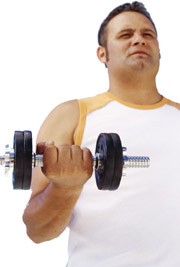
- Strength: The maximum force of a muscle or muscle group.
- Anaerobic power: The maximum strength and velocity of the muscle. Muscle power is a very important determinant of sporting performance.
- Jump performance: Some RT exercises such as the squat can improve jump height.
- Sprint performance: Increased muscle strength can improve sprint performance.
- Agility: Increased muscle strength can improve the body’s ability to rapidly start and stop movements. Agility is especially useful for netballers and footballers;
- Swimming, kicking and throwing: Increased strength has been associated with improved swim sprints, and increased kicking and throwing speed;
- Cardiovascular fitness: RT is not the most efficient way to improve fitness; however, circuit training programs have been shown to improve aerobic capacity.
- Body composition: RT has been shown to decrease body fat, increase lean body mass and decrease fat content.
- Flexibility: Exercises that use the muscles’ full range of motion greatly increase flexibility.
- Muscle growth (hypertrophy): The skeletal muscle growth process is started when muscular force and tension is increased, but the individual muscle fibres will only enlarge when the muscles are overloaded with weight. Enlarged muscles are a major deterrent for many women considering RT. Muscle hypertrophy is the major difference between male and female RT effects; this is due to the larger amount of testosterone in men. Testosterone has high anabolic effects and therefore men will grow muscle more easily and rapidly than women. Correspondingly, people with naturally higher testosterone release will grow muscle more than others, regardless of their gender. Women who incorporate RT in their regular exercise regime will not necessarily grow overly large muscles.
- Improved brain function: RT can improve alertness, especially when exercise occurs in the morning, and coordination.
Resistance training variables
All RT should be progressive. That is, the workout should always be challenging, and the muscles should feel fatigued at the end of each training session. In order to achieve muscle fatigue, the intensity of the workout should increase or progress as the muscles become stronger. This will make sure there is continuous improvement.
There are many variables to consider when increasing the intensity of a RT session:
- Weight/resistance: The level of resistance or tension placed on a muscle group is the biggest determinant of muscle growth and strength building. If unsure, it is always best to ask a healthcare professional whether the weight increase is appropriate. Weights that are too heavy will increase the risk of injury or permanent damage. The weight is too heavy if eight repetitions of the same exercise cannot be done consecutively.
- Set: The set refers to consecutive exercises performed for one muscle group. For example, a certain number of triceps dips repeated with no breaks is one set.
- Set breaks: It is recommended to rest for at least 2–3 minutes between sets to replenish energy in the muscle groups. For a more intense session, the break may be decreased to 1 minute. Smaller breaks may help increase muscle growth, but is not recommended for untrained people.
- Number of repetitions: The number of times a specific resistance exercise is repeated in a set.
- Volume: The total amount of weight lifted in a session.
- Frequency: The number of sessions of RT completed per week. Two sessions are generally thought to be adequate for beginners, increasing up to three or four as they improve; any more than four increases the risk of overtraining. Overtraining is a condition of exhaustion or even chronic fatigue, and is the result of a high intensity workout that the body is not able to adapt to. If the body has not rested enough between sessions, the muscle recuperation process will be incomplete.
- Recovery: As a basic rule, 48 hours between sessions is enough rest to promote muscle regeneration and development. At least 48 hours between sessions will also prevent overtraining.
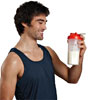 |
For more information on recovery, see Exercise Recovery. |
Designing the training program
Anyone beginning RT for the first time, or experienced trainees who are changing their programs, should seek the help of a coach or sports trainer. Designing a safe, well-balanced RT program is important for achieving the overall goals of the training and for preventing injury. A sports trainer will be able to assess your medical, physical and lifestyle requirements, and design a program that fits in with your schedule and is catered to your tastes and lifestyle. Your willingness to keep up the regime will depend heavily on how well the program is designed.
A sports trainer will need to know:
- What you want to achieve from resistance training. For example, do you want to build muscle or improve your sprinting ability?
- Any medical conditions you have and medication you are taking.
- What other sport is involved in your fitness regime. If there is no other sport, they may suggest you combine RT with some cardiovascular exercise.
- Any previous injuries you have had or any known muscle or bone weaknesses.
- What motivates you to exercise. For example, if you like to work at your own pace at various times throughout the week, a gym circuit is the best option. Alternatively, you may prefer group exercise at regular times.
- Your work/family/sporting schedule. For some, two 60-minute training sessions per week will be more convenient than four 30-minute sessions.
The answers to these questions will determine the types of exercises that will make up the program, which muscles need to be worked, how regular the sessions need to be and what style of training is suitable. For example, more repetitions with a lower weight is more suitable for building endurance, whereas fewer repetitions at a greater weight is more suitable for building strength.
The length and type of warm-up and stretching needed also depends on the intensity of the program and muscle groups used.
 |
For more information, see Preparing For Exercise and Exercise Stretches. |
Discuss your goals with your sports trainer to make sure they are realistic. If you are expecting to lose all body fat and become very fit after only a month or two, you will be discouraged when you do not see these results. The positive changes associated with RT will happen with consistent and progressive training. These changes are gradual, and you must be prepared to commit to the program for six or more months in order to see major results. RT is beneficial for a very wide range of conditions, and if continued for life will greatly improve overall fat, bone and muscle composition. Therefore, RT should be used as a lifestyle change rather than a short-term quick fix.
The training session
- Session order: In order to reduce fatigue, the largest muscle groups (hence the muscle groups that require the greatest resistance) should be done early in the program, working down to the smaller muscle groups. For example, start with the legs and do the shoulders later.
- Muscles trained: It is not always appropriate to train all muscle groups in one session. For some people it may be more appropriate to increase the frequency of training to 4–6 sessions per week, and to concentrate on the legs and back in half the sessions, and the arms and shoulders in the other half.
- Progression: Gradually increase the weights over time as muscle groups become stronger and more powerful. To obtain the best results, each muscle should be exercised until it is fatigued.
- Weight selection: Determining the weight used during the RT session is a very important part of developing the program. The aim is to choose a weight that can be lifted at least eight times in a set. Women who do not want to build muscle should choose a lighter weight that can be lifted 15–20 times in a set. It is highly recommended that you see your sports trainer, group fitness instructor or physiotherapist for the original weight selection, as overestimating the maximum weight you can carry will lead to back and knee damage.
Forms of resistance training
Isotonic (dynamic constant) resistance training
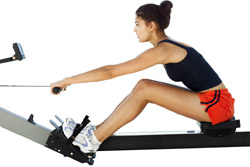
The variable nature of isotonic RT means that it best models natural and functional movements, and allows the recruitment of a large muscle mass. It is best for beginners and people wanting to tone and shape rather than people who are using RT to improve specific muscle strength and power for sporting performance.
Isometric (static) resistance training
An isometric contraction is when the muscle–tendon length does not shorten or lengthen. Isometric contraction is the result of contracting a muscle against an immovable force (e.g. a wall) or against a resistance greater than the strength of the person (e.g. a weight machine).
Isometric contractions are specific to a particular joint angle. This can benefit isotonic training at the joint angle that is weakest when performing the specific resistance exercise. By training up this joint angle isometrically, the muscles that control the weak part of the contraction will strengthen. This also applies for certain muscles affected in sporting injuries and is therefore used in rehabilitation.
Isokinetic resistance training
Isokinetic training is a mixture of both isometric and isotonic RT. Like isotonic training, a constant weight is exercised through the entire range of motion of the muscle; however, the speed is constant with maximum muscle overload. Isokinetic training permits optimal strength improvement along the muscle’s full range of movement. It is performed using a specialised weight machine.
Variable resistance training
Variable training is performed with a weight and pulley arrangement in which the resistance varies as the muscle contracts. The lat pull down and the triceps pull down are examples of variable resistance exercises. The aim of variable RT is to extend and contract the muscle through its whole range of motion. It can lead to significant strength gains.
Plyometric training (explosive jump training)
Plyometric training involves many different jumps, from the ground or from a height. The biomechanics involved are a rapid concentric movement of a specific muscle followed by a rapid eccentric movement, activating the muscles’ natural elastic recoil elements. This form of RT is especially helpful in producing a fast and strong muscle response. It is often used by athletes to improve the flexibility and strength of certain muscle groups involved in a specific sport.
Plyometrics is especially useful for athletes involved in:
- Volleyball;
- Sprinting;
- Football;
- Basketball;
- High jump; and
- Long jump.
There is a high risk of injury with plyometric training as the pressure on the skeletal muscles can be increased up to ten times when jumping from a height. It should only be done 2–3 times per week with proper supervision.
Weight lifting
Weight lifting involves lifting a heavy weight from the floor to a specified position above the ground, holding it for a period, and then putting the weight back on the ground. Weight lifting is mostly used to improve power and stimulate muscle growth.
Weight lifting exercises include:
- Power clean;
- Snatch; and
- Clean and jerk.
There is a high risk of injury associated with weight lifting. It must only be done by experienced people who have had the proper training and have built themselves up to handle the weight.
 |
For more information and examples of resistance training exercises, see Resistance Training Exercises. |
Resistance training for specialised groups
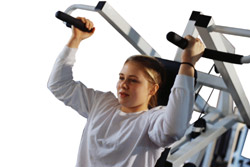
Children and resistance training
RT improves bone status and has positive skeletal outcomes during childhood and puberty. During this growth period, bone mass and bone mineral buildup reaches its peak potential. Enhancing the peak bone mass during this stage is thought to help prevent osteoporosis later in life, though long term follow up studies have not yet been done.
If using weight machines, make sure that the equipment is sized to suit the child. Children should not perform maximum intensity exercises until they are in their mid to late teens, and no weight should be used until they have mastered the correct technique. Children should be supervised at all times when performing resistance exercises.
Pregnant women and resistance training
Resistance training during pregnancy, like any exercise during pregnancy, is safe for well-conditioned women. That is, women who have regularly taken part in RT before conception. All pregnant women should speak to their doctor before beginning any RT so they can be assessed for any risk factors that may be associated with exercising and their pregnancy.

During pregnancy, avoid:
- Isometric contractions;
- Any resistance exercise that requires the woman to lie on her back (e.g. chest press, tricep pullback, abdominal crunches); and
- Heavy weights.
Above all, listen to your body. You will know better than everyone when you need to take a break or reduce the intensity of the session.
Women who have no experience in RT should not begin during pregnancy. Instead, try walking, swimming, cycling, Pilates, or pelvic floor exercises.
 |
For more information, see Pregnancy, Yoga During Pregnancy and Pilates in Pregnancy. |
Post-menopausal women and resistance training
After menopause, women experience accelerated bone loss which puts them at higher risk for osteoporosis. RT as little as twice per week has been shown to be as effective as hormone replacement therapy alone for stimulating bone and muscle formation in post-menopausal women. This can help prevent age-related osteoporosis and sarcopaenia. Hormone replacement therapy in conjunction with RT did not show any significant improvement over RT alone. This means that RT may present a safer option for bone density treatment, with the additional benefit of improving lean mass and muscle strength.
Elderly and resistance training
Research has shown that a combination of isometric and low-intensity plyometric exercise for more than a year improves balance, muscle force and self-rated scales of physical functioning in people over 70 years of age. RT has also been shown to be an effective antidepressant for the elderly, improving morale and self-rated quality of life.
Elderly people should increase their workout intensity at a slower rate than younger people, both to reduce the cardiovascular strain associated with RT and to reduce the risk of injury. A major emphasis with older trainees is support and protection of the lower back, as they are more susceptible to back injuries. The intensity of the program can be reduced by increasing the recovery period and using weight machines as an alternative to free weights. Weight machines place less pressure on a person’s balance, and helps control and manage the weights.
Elderly people generally have a higher recommended protein requirement than younger adults (0.8 g/kg/day). For people aged over 70, an intake of 1–1.3 g/kg/day should provide enough energy.
Type 2 diabetes and resistance training
A major focus of type 2 diabetes treatment is weight loss. However, weight loss is associated with bone and muscle loss. Losing ten percent of weight has been correlated with an increased bone fracture risk. A recent study has shown that a high intensity resistance program combined with a weight loss regime for people with type 2 diabetes prevented bone and muscle density loss, and had the added benefit of increasing lean mass and muscle strength, which helps the management of diabetes.
 |
For more information on weight loss, see Weight Loss. |
Arthritis and resistance training
RT prescribed for optimally stimulating muscle growth can reverse cachexia in people with mild rheumatoid arthritis. Significant muscle growth and increased muscle mass in the trained muscles have been found after 12 weeks of RT.
Due to the disease progression and its treatment, people with rheumatoid arthritis are predisposed to cardiovascular disease and obesity. Hence, RT has added improvements for these outcomes.
By reducing the muscle wasting in rheumatoid arthritis, the long term outcome may be significantly improved. However, further long-term studies need to be conducted.
Using lighter weights with more repetitions is generally most suitable for those with arthritis.
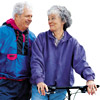 |
For more information, see Arthritis and Physical Activity. |
Cardiac disease and resistance training
The benefits of RT for people with cardiovascular disease are invaluable. RT has been show to diminish cardiovascular symptoms, improve physical functioning, decrease risk profile and improve quality of life.
People with cardiac issues should have a similar program design to those without cardiac issues, but with a low to moderate intensity and a much slower rate of resistance progression. If they find themselves physically exerted, they should decrease the volume of the session. They should aim to work up to 30 minutes of resistance exercise on most days of the week.
Note that beta blockers may interfere with the normal temperature control of the body during exercise. This may have negative consequences if not monitored. Speak to your doctor about this.
 |
For more information, see Physical Activity with Cardiovascular Disease. |
Rehabilitation and resistance training
Muscle conditioning is an integral component of rehabilitation in sporting injuries, as muscles will experience a degree of wasting (atrophy) as a result of disuse. Muscles need to be reactivated and “re-educated”, as well as strengthened and trained for increased power and endurance. The program designed should be specific to the injury received. As with all programs, rehabilitation needs to progress at a slow enough rate to reduce the risk of further injury. High repetitions with low resistance should be used to build up strength before the volume of the session is increased.
Quick tips for resistance training
In summary:
- Always speak to your doctor before beginning an RT program to ensure your body will be able to manage the training. If you have a health condition, your doctor will offer advice about the extra necessary precautions you need to take.
- Avoid overloading weight and always gradually increase weights. It is better to begin with a suboptimal weight than a maximum weight, which will greatly increase the risk of injury in untrained people. An alternative way to fatigue the muscles is to increase the number of repetitions instead of the weight.
- To improve flexibility and prevent muscle shortening, all exercises should use the full range of motion in the muscle.
- Loading a muscle involves only half the range of motion. For example, only rising half way up and down when squatting will place a lot more tension in the quadriceps. This is a good way to improve muscle strength, but it does not exercise the full muscle contraction and should therefore be combined with full squats. If loading the muscle during the exercise, the muscle needs to be stretched sufficiently after the exercise. No full set should contain only heavy load repetitions.
- A low intensity and uniform warm-up must always precede RT.
- The techniques must be practised in front of a trainer to ensure it is correct. The first session should comprise of very little or no resistance.
- To prevent injury, the core muscles (hips, pelvis, lower back and stomach) should be stable and tightened at all times. Tightening the core muscle will ensure the back is never arched and the hips do not thrust forward. The only muscles that should be moving are the ones contracting against the resistance.
More information
 |
For more information on fitness and exercise, including stretches, types of exercise, exercise recovery and exercise with health conditions, as well as some useful videos, see Fitness. |
References
- Feigenbaum MS, Pollock ML. Prescription of resistance training for health and disease. Med Sci Sports Exerc. 1999; 31(1): 38-45.
- Brukner P, Khan K. Clinical Sports Medicine (3rd edition). North Ryde: McGraw-Hill; 2006.
- Sports Medicine Australia. Sports Medicine for Sports Trainers (9th edition). Marrickville: Elsevier Australia; 2007.
- Hoffman J. Physiological Aspects of Sport Training and Endurance. New Jersey: Human Kinetics; 2002.
- McArdle WD, Katch FI, Katch VL. Exercise Physiology: Energy, Nutrition, and Human Performance (5th edition). Baltimore: Lippincott Williams & Wilkins; 2001.
- Lucas M, Heiss CJ. Protein needs of older adults engaged in resistance training: A review. J Aging Phys Act. 2005; 13(2): 223-36.
- Marcora SM, Lemmey AB, Maddison PJ. Can progressive resistance training reverse cachexia in patients with rheumatoid arthritis? Results of a pilot study. J Rheumatol. 2005; 32(6): 1031-9.
- Maddalozzo GF, Widrick JJ, Cardinal BJ, Winters-Stone KM, Hoffman MA, Snow CM. The effects of hormone replacement therapy and resistance training on spine bone mineral density in early postmenopausal women. Bone. 2007; 40(5): 1244-51.
- Karinkanta S, Heinonen A, Sievänen H, Uusi-Rasi K, Pasanen M, Ojala K, et al. A multi-component exercise regimen to prevent functional decline and bone fragility in home-dwelling elderly women: Randomized, controlled trial. Osteoporosis Int. 2007; 18(4): 453-62.
- Singh NA, Clements KM, Fiatarone MA. A randomised controlled trial of progressive resistance training in depressed elders. J Gerontol A Biol Sci Med Sci. 1997; 52(1): M27-35.
- Hind K, Burrows M. Weight-bearing exercise and bone mineral accrual in children and adolescents: A review of controlled trials. Bone. 2007; 40(1): 14-27.
- Daly RM, Dunstan DW, Owen N, Jolley D, Shaw JE, Zimmet PZ. Does high-intensity resistance training maintain bone mass during moderate weight loss in older overweight adults with type 2 diabetes? Osteoporosis Int. 2005; 16(12): 1703-12.
- Kardel KR, Kase T. Training in pregnant women: Effects on fetal development and birth. Am J Obstet Gynecol. 1998; 178(2): 280-6.
- Sports Medicine Australia. SMA statement the benefits and risks of exercise during pregnancy. J Sci Med Sport. 2002; 5(1): 11-9.
All content and media on the HealthEngine Blog is created and published online for informational purposes only. It is not intended to be a substitute for professional medical advice and should not be relied on as health or personal advice. Always seek the guidance of your doctor or other qualified health professional with any questions you may have regarding your health or a medical condition. Never disregard the advice of a medical professional, or delay in seeking it because of something you have read on this Website. If you think you may have a medical emergency, call your doctor, go to the nearest hospital emergency department, or call the emergency services immediately.







